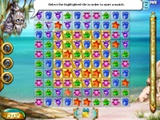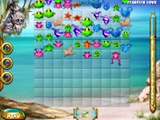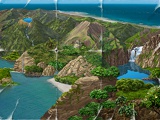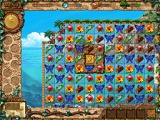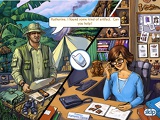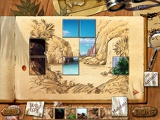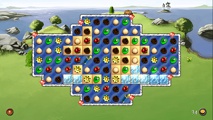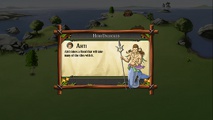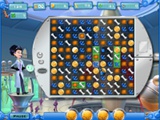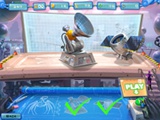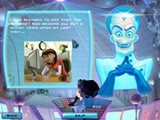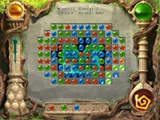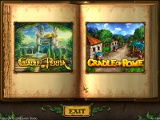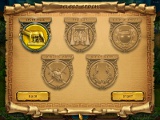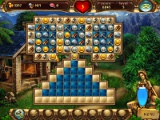





Power Puzzle Pack 3-in-1:
Galapago
Paradise Quest
Galapago was a preinstalled Acer GameZone demo. It is bundled with Paradise Quest in Island Adventure Duo, and the two of them are bundled with Treasures of the Serengeti in Power Puzzle Pack 3-in-1. The third game is not a real match-3 game, and is included in at least one other bundle. Anyway, the two other games are just a bonus, because my reason for buying the bundle is Galapago.
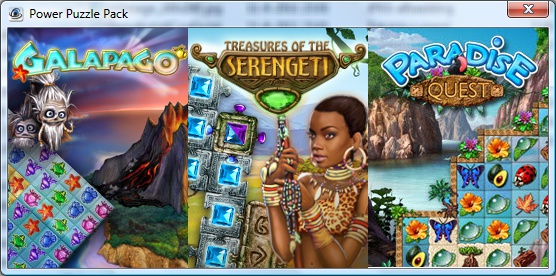
The idea behind Galapago is to free animals from a grid before a
volcano erupts. The island and the beach around it are divided into many
sections, all of which have their grids of local wildlife that needs to be saved
from this remarkably active volcano. The animals are simple and done in bright
colours: lilac, purple, orange, green. When the level is finished, they run, hop
and wing their way to the top of the screen; clicking on them adds extra points
to the score. There are trophies to be won in the form of gilded statuettes of
these animals, displayed in the My Collection screen. The grids are standard
match-3, starting simple and adding challenges like barriers and "frozen" tiles,
as well as special powerups to smash problem tiles or to make two non-adjacent
tiles change places. The player is supposed to start on the beach and move
inwards, but doesn't have to follow a set order; the difficulty of each level is
shown in stars in the screen where the player chooses the next playfield. While
playing, I am entertained by beach music and the gigglings and gurglings of two
shrunk heads hanging from a tree, who watch the tile-switching with interest and
bubble with delight at any move that scores a high number of points.
Paradise Quest, though also connected with a tropical paradise
island, is nothing like that, and despite having far prettier graphics and an
actual backstory, is much less fun. Here, you can't simply pick a stretch of
beach and start clicking. You are an archaeologist come to the island of Isabela
and must repair its ecosystem by playing match-3 (because that is how ecosystems
recover, yes, really) while also hunting for artifact stones which then become
scenery puzzle pieces. The playfield is bigger than the screen and - argh -
scrolls around; the only way to move it is to make matching rows in the
direction you want to go. It's another one of those games that give me a
headache. As said, the graphics are nice, though, as is the jungly background
music. And it's educational, revealing snippets of information on wildlife of
the kind seen by people who travel to real tropical islands, rather than playing
match-3 games in a very odd attempt to save them.
Heroes of Kalevala (demo)
The Kalevala is a Finnish epic. I don't know anything about it except that
the Finnish composer Sibelius composed something based on it. I don't know if it
has heroes. Or if, like the game, it is about settlers looking for a new place
to live. I do suspect, seeing pictures of these settlers and their wagons, that
the game was originally meant to be about pioneers travelling west in the USA.
Maybe that idea was scrapped because part of the game is chasing out the people
who already live there, which would bring up the massacres of native Americans,
and that would be just too painful. The single person about to be displaced by
the influx of settlers, announced by the stupidly pompous voiceover at the
game's intro, is a witch. She doesn't appear, she just sends her crow to scare
off the newcomers, and act as timer for every match-3 game level. It's a pretty
standard game, following match-3 conventions: line up three or more tiles with
themed pictures (in this case, pinecones, crowberries, the things found along
Scandinavian coastlines), collect points to buy stuff for the settlers, get an
obstacle here, a bonus there, and collect bits of magic cards which give you
super powers, such as, in the second screenshot, the hero Ahti, who raises a
flood that will take many tiles with it. Not knowing the Kalevala, I can't
comment on the authenticity of these heroes. I can comment on the authenticity
of the background music: kantele (Finnish harp) or something that sounds like
it.
Despite the background music, and the fact that this (as visible from the
screenshots) is one of the rare games to fit comfortably in a wide laptop
screen, I scrubbed it. Sorry, my sympathy lies with the witch. Who invited
these settlers, anyway? Why couldn't they stay where they were, and if they had
to leave because they squandered their previous habitat's resources, what's to
say they'll do better here? Off with them.
Dr Despicable's Dastardly Deeds
What's a poor brilliant inventor (with an accent like Sophie Lipkin from
The Powers That Be) to do when her attempts to automate any menial job
she manages to find, get her fired even from burger-flipping? When (in a dream?)
a Dr. Despicable approaches her, wanting to make use of her special talents,
she's in no position to refuse. His line of work is pesky terrorism: things like
shrinking all the jeans in every clothes shop. The brilliant inventor helps
create the machines necessary to carry out his evil schemes on a global scale...
through... match-3 sessions. The points gathered in these sessions (with or
without timer) pay for different kinds of machinery. The game is funny, and
satirizes, among other things, telemarketing centres, and it feels great to be
the villain - but this is another game that stretches my credibility too far.
Sorry, there are things that cannot be accomplished simply by switching tiles,
and the tile-switching offers no rewards (kooky sound effects, particularly) by
itself.
Reinstalling it to make screenshots, I gave the game a second chance, and
ended up buying it. Yes, the tile-switching is tedious, but as my tile-matching
skills have improved, it doesn't last as long, giving me less gameplay and more
of that delightfully devilish story. When the stupid neighbours' dog is barking
again, or people annoy me in some other way, this game allows me to live out my
fantasies of getting back at them without having to resort to outright violence.
Glyph 2 (demo)
The hidden object game Kuros is a spinoff from
the match-3 Glyph games. It is connected through the planet it takes place on -
Kuros - and the glyphs, special characters with special effects. Having played
Kuros and loved its graphics, I wanted to try the Glyph games, but finding them
was not so easy. Glyph 2 could only be found on the Acer Gamezone site (but has
since then appeared on CasualGames.com), while the first game, Glyph, was hidden
away on Oberon's own site under "Vintage games" (and is now bundled with Kuros).
Being so old, the second Glyph game is installed in a different way from most
games, and harder to transplant from C: to another drive, which bodes ill for
the first game. What also bodes ill for the first game is that in the second
game, I can't inscribe glyphs. An example appears onscreen, which I am supposed
to trace with the mouse cursor. I do. It doesn't work. This is a problem, since
the tile-busting powers that normally come from magic cards are here evoked
through glyphs. And if the game won't interpret mouse movement correctly, who
knows what else won't work. As a sour cherry on the cake, if I play while
connected to the internet, I'm shown commercials and a plaintive message to
"please support our sponsors". This game will be scrubbed, and I hope Oberon
releases it (and the first game, too, that would be nice) in a modern bundle
that can be moved to another drive without problems, and doesn't have hardware
issues.
Anyway, the summary, which is the same for both games, is that the planet
Kuros is dying, and can only be restored by unleashing the power of the five,
yes, five elements: wood, fire, metal, earth and aether. The graphics seem
pretty, although, due to the technical problems, I've not seen a lot of them.
Cradle of Rome from The Cradle Bundle (demo)
Unlike Cradle of Persia from the same
bundle, this is a match-3 game. Its levels follow the history of Rome, starting
with the myth of Remus and Romulus being raised by a wolf. Like its companion
game, it has a water-themed timer, in this case an urn. The goal is the same:
collect points to buy buildings and create a town, by destroying tiles,
especially those on a blue square, and obstacles like a "chained" tile, the
destruction of which, in the third screencap, leads to a dramatic pouring of
tiles into the lower playfield. The score for each tile is displayed above it as
it disappears; some tiles contribute to a "power", like a hammer to break up a
clogged playfield, and some have no value. Its backgrounds are greener than the
Persian dusty desert backdrops, but while every successfully completed stage is
celebrated with fireworks and a change of scene in both games, the background in
Cradle of Rome seems to change for every building I add; the button to
the right with the eye on it makes the game bars disappear, for an unobstructed
view of my achievements. The music and sound effects are charming: harp in the
background, a funny sound when I do something wrong and a trumpet when the level
is finished. There are game bonuses like "farmer" for matching 5 tiles in a row,
and "miner" for scoring a certain amount of points. Again, the player has three
lives and a status that is raised with the number of points scored; the first
step on the ladder is "peasant".
